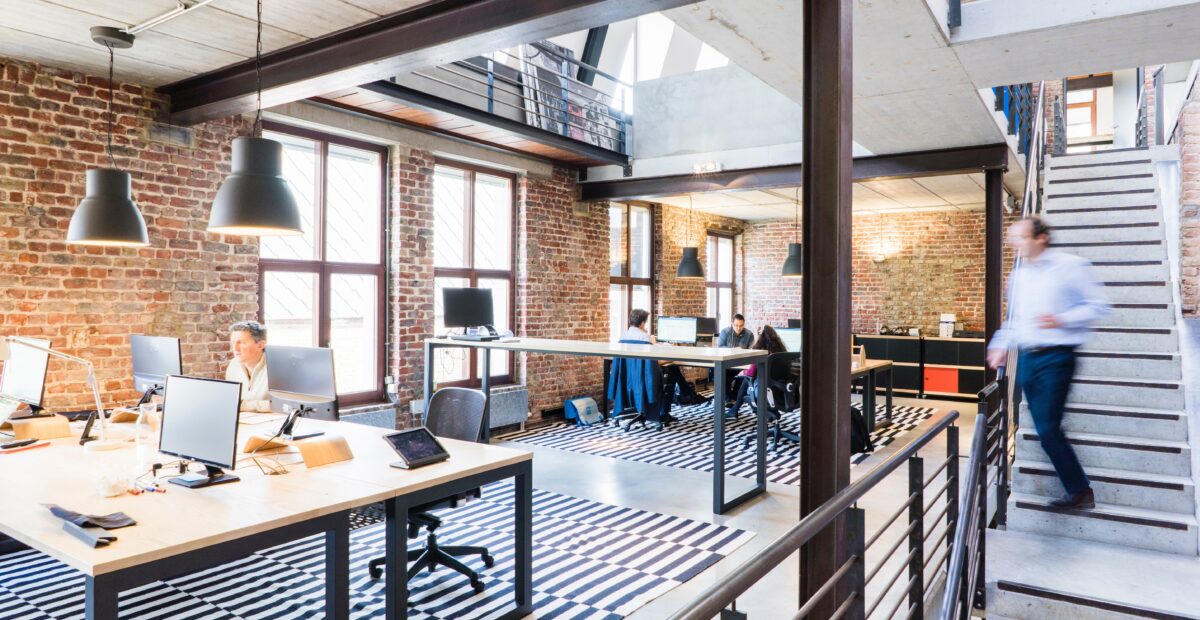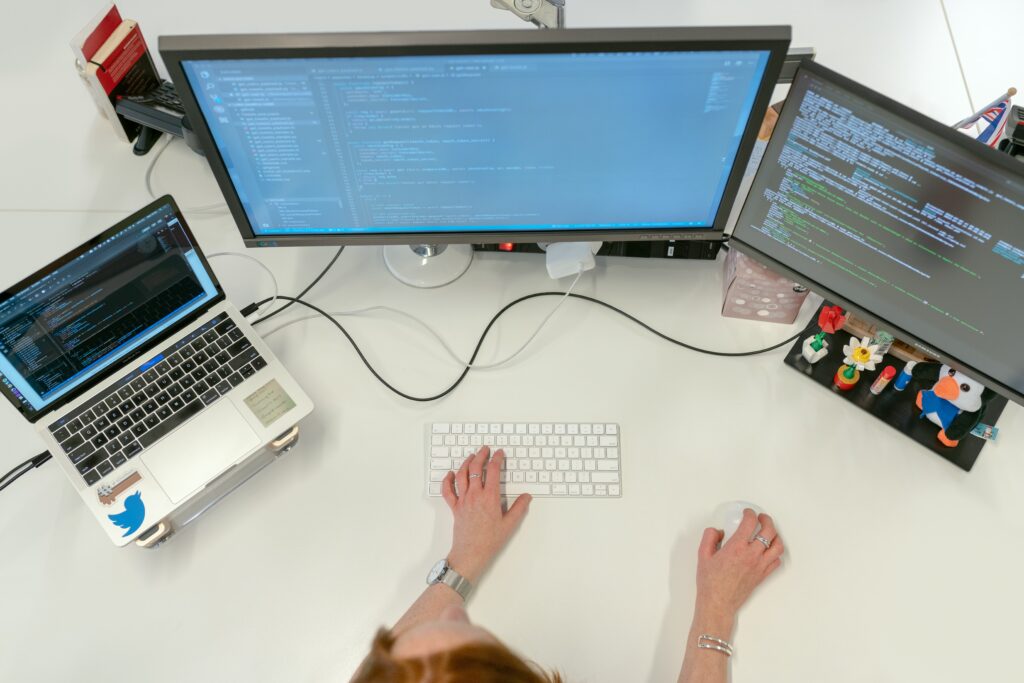Neurodiverse Design: How to Create Inclusive Workspaces

Featured image by Proxyclick, Pexels
Why is it important to make workspaces inclusive?
Are you reading this from your office or workplace? Now listen around and notice how many noises you can perceive. Keyboard clicking, phone ringing, fan noise, printer printing, people talking, doors opening and closing… All of these and so much more sound and playing simultaneously. Now add some gleaming screens, a dazzling light, lots of blurry signs, textures and patterns moving, confusing wayfinding and a wide panoply of annoyance…
The result is discomfort and sensory overload if you are a neurodivergent individual…
Understanding of neurodiversity is growing among the public, and so is the need to create, design, and adapt inclusive workspaces for neurodivergent people, as just the lighting, the noise or the way spaces are designed can distress them and impact their daily life and work performance. So, an adapted workplace can help neurodivergent people:
- Being more proactive
- Being committed
- Being more self-confident
- Performing better
- Improve well-being
- Completing tasks more efficiently
All this results in productivity enhancement; making the most of neurodivergent individuals can make a team resolve more complex problems and add new perspectives and different ways of thinking to bring about innovation and creativity. If you are an employer and would like your company to understand the strength of neurodiversity and upskill its workforce, you can book Neurodiversity Training at Exceptional Individuals.
We know that 20% of the world population is neurodivergent -that is 1 in 7 individuals in the UK. They normally think out of the box, having specific strengths. That is the reason why neurodivergent individuals add value to companies like Google or Microsoft, and so many more, are already targeting neurodivergent people for their recruiting processes as they truly know they are a positive benefit for businesses. The BBC, for instance, has specific programmes to promote acceptance and appreciation of neurodiversity. They do it throughout BBC Cape, “a neurodiverse initiative to remove barriers in the workplace and open opportunities for neurodivergent employees by improving the understanding of and support available for people with conditions such as Autism Spectrum Condition, Dyslexia, Dyspraxia and Tourette’s”.
On the other hand, we also know that sensory overload can be a challenge for some people who are neurodivergent, so employers have started to create environments using neurodiverse design (adjustments may vary depending on each individual and sometimes are easy to carry out) so that neurodivergent individuals do not find the office a distressing and uncomfortable place, ultimately a barrier. In addition, a workplace needs assessment can help to identify solutions to challenges experienced by an employee at the office.
That is becoming so relevant to the point that the British Standard Institution recently launched the guide PAS 6463 about neurodiversity and the built environment: Design for the mind -Neurodiversity and the built environment- Guide where you can find the BSI guidance about how negative impacts can be eliminated, reduced or adjusted, addressing considerations, such as lighting, acoustics, flooring, décor, layout, wayfinding, familiarity, clarity, safety, thermal comfort, odour…
How can you make your workspace more inclusive?
It is very well-known how a space’s design affects the five senses. Temperature, textures, acoustic, colours… Everything may have a negative influence on a person’s well-being and his/her productivity. Even more, the lack of an adapted environment may cause the employee to avoid going to the office. So, designing the space focusing not only on the employee but the person, the individual, always has a positive impact on physical, mental and social welfare, as well as on the company results.
Each business in the UK must offer help to employees when they have a disability -visible or not- if they ask for a reasonable adjustment to help them to do their job. That is due to the Equality Act 2010. The implementation of adjustments is easier when done from the concept stage than retrospectively as it is more expensive, more disturbing and less effective, PAS 6463 points out. However, most of the time, companies can adapt their workspaces with a bit of change.
You can make a workspace more inclusive by considering the workplace through the five senses:
- Personalising room temperature control: it is pretty difficult to be productive in a too-cold or too-warm environment for anyone, and it can be a big problem for neurodivergent individuals.
- Offering noise-free areas to help autistics or people with ADHD, who are super sensitive to noise and can be acutely bothered by office activity.
- Reducing visual overload
- Using natural or dim lighting. Using a window covering to reduce the glare should help people with Irlen Syndrome, as bright or fluorescent lighting usually exacerbates their symptoms.
- Zoning. Providing a wide array of areas, dividing the space.
- Allowing flexible area sitting: people can choose where to sit depending on lighting, glare, noise, and smell…
- Using/avoiding certain colours and patterns can trigger a high sensory stimulation level.
- Avoid narrow corners and corridors. Some neurodivergent people dislike physical contact and socialising. It usually happens in autistic individuals. On the other hand, individuals with Irlen Syndrome have deep perception issues and bumping into things/people can be usual for them. Others, like people with dyspraxia, have coordination problems, so wide spaces for circulation are a good point to help them.
- Offering low-traffic areas to avoid physical contact.
- Allowing the use of noise-cancelling headphones.
- Wayfinding: using colours to help make spaces more memorable, but taking into account the brightness of colours as it can cause disturbing. In addition, engaging and intuitive navigation elements can help a lot.
- Green spaces or decoration: natural elements and green spaces evoke calm, relaxation and refreshment.
Create private spaces for employees to work

Image by Andrea Piacquadio, Pexels
Autistic people and individuals with ADHD are very sensitive to noise and can get pretty distressed, so a private space or pod to take a break or even to work isolated can be a brilliant solution to face noise overload and avoid distractions to perform the best. On the other hand, isolation can be necessary for people with social relationship issues. Furthermore, some individuals do not feel comfortable working with their backs to an open office, and an enclosed space might be a good deal. So, giving people the choice to work in areas that suit their preferences better is telling them they matter to the employer and the company.
Allow staff to take breaks

Image by Alexander Suhorucov, Pexels
A different adjustment to help neurodivergent employees perform better is allowing short breaks throughout the day out of the desk, which can truly improve attentiveness and focus. We know workers are entitled to a daily 20 minute break when daily working time is more than six hours, but that is not enough for individuals with neurodivergence, that usually get sensory overstimulated.
People with unusual concentration spans, such as people with ADHD, may find long work duties without breaks very difficult, and stress and anxiety become worse without a 10-15 minute break. This may mean adapting working core hours.
Assign a line manager or buddy for support

Image by Yan Krukau, Pexels
Starting a new job can be stressful for everybody as you have to face new people, new tasks, new environments, new procedures and new work challenges. All this can become a big concern and a barrier if the employee is a neurodivergent individual that may have difficulties recognising/remembering people’s faces, socialising or finding places for instance.
Assigning a line manager or buddy for support can make a difference as they become like the road map to navigate the workplace because they give support, advice and guidance:
- Gives context about the place and the rest of the workforce.
- You can ask and check everything with him/her: provide detailed and complete information, and you can ask everything twice.
- Helps to understand social and cultural company norms.
- Helps to know what is expected from you, at a meeting, etc.
- Helps with group integration and social inclusion.
- Helps to understand what people say and to decode speeches: some individuals with neurodivergence do not understand jokes, vague instructions, double meanings, metaphors or ambiguities.
- They are rather clear and direct instructions to know what is expected from them or what people mean.
- Makes the neurodivergent workmate feel empowered, valuable and part of a team.
Offer assistive technology

Image by ThisIsEngeneering, Pexels
Assistive technology (AT) is a device, software or technology that helps people with visible or invisible disabilities, as well as learning differences such as ADHD, autism or dyslexia, to develop their work tasks. AT also can help to accomplish the office modifications.
There is a wide array of assistive technology for neurodiverse people that can enhance their work performance and can be very helpful in their daily life.
The most common are:
- Text to Speech software
- Speech to text software
- Transcription tools
- Handheld reading devices
- Noise-cancelling earbuds
- Spell checking and word prediction
- Screen and text readers
Assistive technology for dyslexia
People with dyslexia can struggle with writing and spelling, resulting in a lack of self-confidence, and excessive fear of failing, lack of learning motivation and self-undervalue. In this case, there are several ATs able to turn speeches into text, visually plan work or to automatically correct the grammar and spelling in documents.
Assistive technology for autism
Autistic individuals present difficulties with language, movement and learning. Impulsiveness, hyperactive conduct, inflexible routines or ritualised patterns are other characteristics of the autistic trait. For them, simple objects such as sensory balls or picture boards can make a difference. On the other hand, visual timers, battery-operated toys, social skills videos or even robots can help them to build social skills.
Assistive technology for ADHD
Assistive technology (AT) for people with Attention Deficit Hyperactivity Disorder help individuals not only with their work performance but also their daily life. By using AT, they can concentrate and focus better, can keep track of time, get help with vocabulary and reading or even take notes more effectively.
If you want to know what specific Assisted Technology is available for each trait, you can read What is Assistive Technology, where you can find out more specific information about the most popular tools, software, technology, and devices.
Webinar: Neurodiversity Inclusive Design
Nat Hawley, our Head of Community, has hosted a webinar about how workspaces can be designed to be neurodiversity inclusive.DISCLAIMER: The quality of this webinar is lower than usual due to Nat having recorded it in a different way than normal and the video of him being pixelated at times, especially on devices with larger screens. To salvage this webinar, our Content Volunteer April cropped and shrunk the video footage of Nat and placed it over better quality still slides (the slides were pixelated and cropped in the original broadcast of this webinar). April also removed some of the still slides because she thought they would not work as well as their animated versions.
Blog Author

Natalia Herrero López




